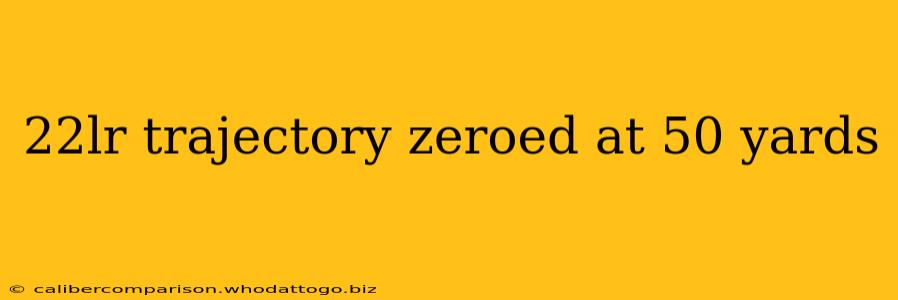The .22 Long Rifle (22LR) cartridge is a popular choice for target shooting, small game hunting, and plinking, thanks to its affordability and relatively low recoil. However, understanding its trajectory is crucial for accuracy, especially when zeroing at 50 yards. This distance represents a common zeroing point for many 22LR rifles, offering a balance between close-range accuracy and sufficient sight adjustment for longer ranges.
Understanding Trajectory and Ballistics
Before delving into the specifics of a 50-yard zero, let's briefly cover the fundamentals of bullet trajectory. When a bullet leaves the barrel, gravity immediately begins to pull it downwards. This downward pull, combined with air resistance, creates a curved path – the trajectory. The point where the bullet's trajectory intersects your line of sight is the point of impact (POI). Zeroing your rifle involves adjusting your sights to align the POI with your point of aim (POA) at a specific distance – in this case, 50 yards.
Why 50 Yards?
Choosing 50 yards as a zeroing distance for a 22LR offers several advantages:
- Acceptable close-range accuracy: A 50-yard zero often provides acceptable accuracy at distances closer than 50 yards, making it suitable for various shooting applications.
- Sufficient sight adjustment range: It provides enough sight adjustment to compensate for bullet drop at longer ranges, albeit with some additional holdover or hold-under required.
- Practical zeroing distance: 50 yards is a manageable distance for most ranges and allows for accurate zeroing without requiring excessive space.
Factors Affecting 22LR Trajectory at 50 Yards
Several factors influence the trajectory of a 22LR bullet at 50 yards, impacting the accuracy of your zero:
- Ammunition: Different 22LR ammunition types (e.g., high-velocity, subsonic, hollow point) exhibit varying ballistic characteristics. The bullet weight, velocity, and construction all play a significant role. Consistent ammunition is paramount for accurate zeroing.
- Rifle characteristics: The rifle's barrel length, twist rate, and overall condition (cleanliness, etc.) can subtly affect accuracy and trajectory.
- Environmental conditions: Wind speed and direction, temperature, and atmospheric pressure all influence bullet flight. These factors necessitate adjustments to your aim, especially in less-than-ideal conditions.
- Sight type: The type of sights used (iron sights, scopes, red dots) impacts zeroing procedure and the potential for accurate adjustments.
Zeroing Your 22LR at 50 Yards: A Step-by-Step Guide
Zeroing a rifle accurately requires patience and careful attention to detail. Here's a general approach:
- Safe gun handling practices: Always prioritize safe gun handling practices. Ensure the rifle is unloaded and pointed in a safe direction throughout the process.
- Stable shooting position: Utilize a stable shooting rest or benchrest to minimize movement during the zeroing process.
- Initial sight adjustment: Start with a rough estimate of sight adjustment, considering the ammunition type and rifle characteristics.
- Shooting groups: Fire three to five shots at 50 yards and observe the group's location.
- Sight adjustment: Based on the group's location, adjust your sights accordingly. Most sights utilize windage and elevation adjustments to align the POI with the POA. Remember, small adjustments make a big difference.
- Repeat: Continue the process of shooting groups, observing, and adjusting until the POI is consistently centered at 50 yards.
Beyond 50 Yards: Understanding Holdover and Hold-under
Once your rifle is zeroed at 50 yards, you'll need to compensate for bullet drop at longer and shorter ranges. This is achieved through holdover (aiming higher) or hold-under (aiming lower) techniques. Practicing at various distances with your chosen ammunition will help you develop an understanding of the necessary adjustments.
Remember, consistent ammunition, a stable shooting platform, and practice are key to achieving and maintaining an accurate 50-yard zero for your 22LR. Always consult your firearm's manual for specific instructions and safety guidelines.

